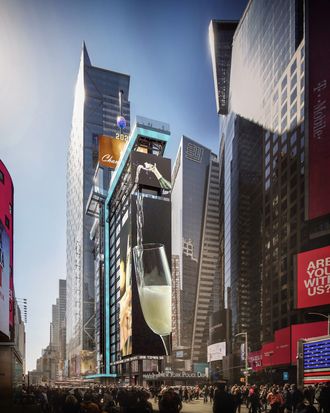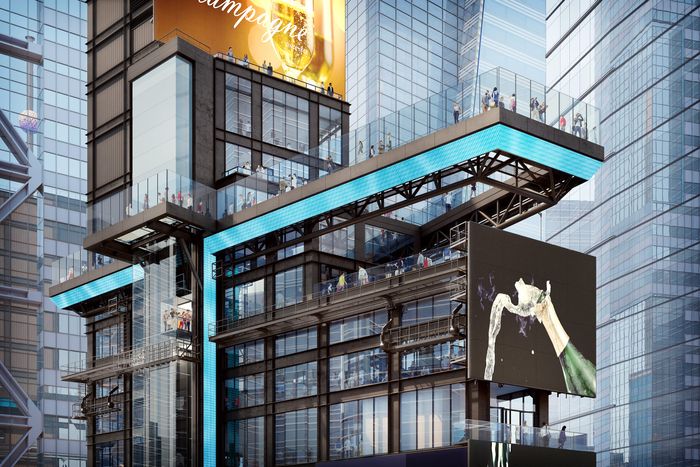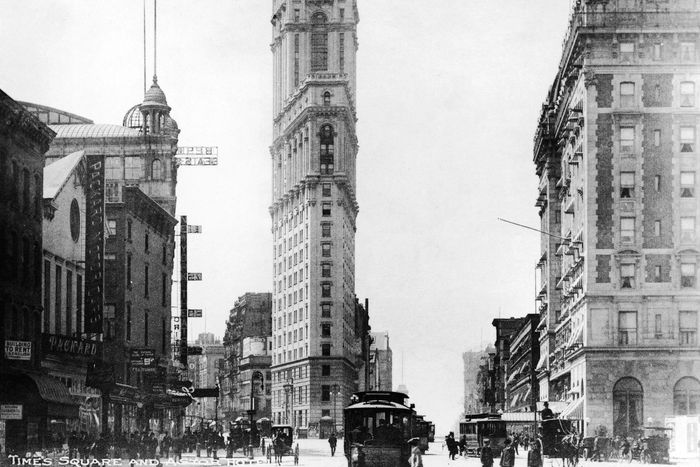
For several decades, One Times Square, the wedge-shaped building on the corner of 42nd Street and Broadway famous for the New Year’s Eve ball drop, has struggled to balance advertising with anything else. Built by the New York Times in 1904 and briefly used as the paper’s headquarters, the 26-story tower has prominently displayed ads on its façade since the 1920s, when the Zipper, a five-foot-high ribbon of illuminated headlines, first encircled its base. But it wasn’t until 1995, when Lehman Brothers bought the building and then sold it to Jamestown Properties, that advertising took over to the exclusion of pretty much everything else. Rather than spend money on a renovation of the shabby interiors, which had been mostly vacant since the 1970s, the new owners instead exploited the building’s position anchoring the southern edge of Times Square, turning the entire thing into a giant billboard. Yet if you walk by now, you will see that the ads have been stripped from three sides of the building, revealing a grimy façade covered with rusty brackets. That’s because Jamestown has gone all the way: It’s undertaking a $500 million redevelopment that will turn the inside of the building into ad space as well.
Jamestown, the longtime owner of Chelsea Market (which Google bought for $2.4 billion in 2018) plans to lease 12 floors of One Times Square for branded experiences. Companies will take over half or full floors, building out immersive spaces with digital, virtual, and augmented-reality integrations. They’ll likely be similar to the interactive van Gogh exhibit, but instead of feeling surrounded by fields of sunflowers, visitors might be immersed in the world of Coca-Cola or Kia. (Jamestown estimates that leases will run three to five years, long enough for companies to justify extensive build-outs but only about a third of what a traditional commercial lease would be.) Another six floors will become a museum that will “tell the story of the building, New Year’s Eve celebration, and its place in the history of Times Square” — that is, kind of an ad for Times Square itself. The whole thing will be topped with a viewing deck, the go-to for any new tourist attraction these days, though One Times Square has the distinction of being not so much above it all, like One Vanderbilt or the Empire State Building, but very much in the middle of things. “It’s the only building in the world that has a physical piece — celebrating New Years and the ball dropping — and also an advertising piece. It’s the only one that ties everything together,” said Michael Phillips, the company’s principal and president.
The redevelopment includes a new subway entrance (already in place) beneath the building and a virtual component in the Decentraland metaverse, so less hearty souls can attend the ball drop without being trapped in the cold for hours sans bathroom. The building will also have retail on the ground floor in a space that was, until recently, occupied by a Walgreens.
There will just one floor of office space, a use the building doesn’t really lend itself to anymore despite having been built for that purpose. For the past 20 years, the only office tenants have been the New Year’s Eve production staff, according to Phillips, who will return, taking over the 22nd floor after the renovation. “Its utility as an office building was somewhat limited — it was wrapped in signs, and the floor plates are quite small,” he said. “A long time ago, there was a restaurant and club, but we really did operate it like a signboard with retail at the base.”
When it was new, a major appeal of the building was its abundance of windows. Unlike a mid-block building, it stood entirely free of its neighbors, “a tremendous marketing asset and, in the days before air conditioning … a considerable plus for tenants,” according to the blog Daytonian in Manhattan. It was also quite nicely detailed, though in 1965, the building’s new owner, the Allied Chemical Company, stripped off all the ornate terra-cotta and replaced it with flat marble cladding. (Allied Chemical also tried to promote it as a tourist destination with exhibitions on three floors.) The tower narrowly missed being razed in a 1980s redevelopment scheme, and in 1990, it got its first JumboTron screen — a sign of things to come. Many considered the $27.5 million that Lehman spent in 1995 to be an almost comical overpayment, but Lehman was the one laughing: Two years later, after proving how lucrative it was to operate the building purely as billboard scaffolding, the firm sold it for roughly four times that price to Jamestown.
Today, the advertising space is considered some of the most valuable in the world with more than 130 million pedestrians passing by in a typical year (to say nothing of all the building’s film, TV, and Instagram appearances). And Jamestown isn’t going to let construction get in the way of that: The company says the north-facing LED signs — the building’s most valuable — will continue broadcasting uninterrupted throughout the approximately 27-month construction period. The ball drop, of course, will happen on schedule as well.







